 Woodlands, prairies, wetlands, caverns, bluffs, lakes, beaches, rivers and springs — Florida State Parks are definitely more than places to protect our natural landscapes and the species within. Our state parks are also places that protect the stories of our past. Part of that past includes the birth of our state park system – the land, the layout and the recreation facilities created during the tough times of an economic depression.
Woodlands, prairies, wetlands, caverns, bluffs, lakes, beaches, rivers and springs — Florida State Parks are definitely more than places to protect our natural landscapes and the species within. Our state parks are also places that protect the stories of our past. Part of that past includes the birth of our state park system – the land, the layout and the recreation facilities created during the tough times of an economic depression.
Developed under the New Deal Era of President Franklin D. Roosevelt, the Civilian Conservation Corps provided jobs for young men during the Great Depression. The program implemented one of the largest natural and cultural resource conservation efforts in US history.
In 1933, the Civilian Conservation Corps (CCC) was the first New Deal agency to begin operations in Florida. From 1933 to 1942, the CCC and the Works Progress Administration, another program established under the New Deal, constructed an impressive collection of facilities throughout Florida, including nine state parks.
Two of those state parks – Torreya and Florida Caverns – are within day-trip distance of Tallahassee.
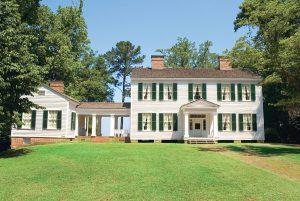 1. Torreya is one of the original Florida State Parks. The site was selected to be a park not only because of its steep forested ravines, rare Torreya trees, and scenic bluffs overlooking the Apalachicola River, but because it possessed significant historical associations. These associations include six Confederate gun pits along Neal’s Bluff and an antebellum cotton warehouse at Rock Bluff Landing. The CCC quickly added another historic resource to the park – the Gregory House. The historic plantation mansion was located across the Apalachicola River from the park and was dismantled, hauled across the river, and reconstructed at its current location. Tours of the historic home are available.
1. Torreya is one of the original Florida State Parks. The site was selected to be a park not only because of its steep forested ravines, rare Torreya trees, and scenic bluffs overlooking the Apalachicola River, but because it possessed significant historical associations. These associations include six Confederate gun pits along Neal’s Bluff and an antebellum cotton warehouse at Rock Bluff Landing. The CCC quickly added another historic resource to the park – the Gregory House. The historic plantation mansion was located across the Apalachicola River from the park and was dismantled, hauled across the river, and reconstructed at its current location. Tours of the historic home are available.
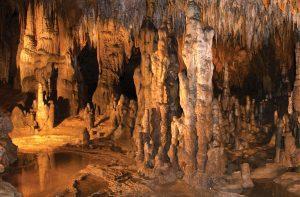 2. At Florida Caverns State Park, the Civilian Conservation Corps and Works Progress Administration initiated park development, which included the preparation of the tour cave. During the 1930s, workers removed mud, broadened passages, added headroom and installed lighting. The CCC also constructed the visitor center. Built with stone masonry on concrete foundations, the structure is still in use and features exhibits where visitors can learn about the cave system and CCC history.
2. At Florida Caverns State Park, the Civilian Conservation Corps and Works Progress Administration initiated park development, which included the preparation of the tour cave. During the 1930s, workers removed mud, broadened passages, added headroom and installed lighting. The CCC also constructed the visitor center. Built with stone masonry on concrete foundations, the structure is still in use and features exhibits where visitors can learn about the cave system and CCC history.
 3. O’Leno State Park, along the banks of the Santa Fe River, is located near High Springs. The site of the park was initially a Florida Forest Service Camp used for forestry training and education. Between 1935 and 1936, the CCC cleared land, built roads and trails, and constructed the dining hall, pavilion, museum and suspension bridge. In October 1940, the camp was transferred to the Florida Park Service.
3. O’Leno State Park, along the banks of the Santa Fe River, is located near High Springs. The site of the park was initially a Florida Forest Service Camp used for forestry training and education. Between 1935 and 1936, the CCC cleared land, built roads and trails, and constructed the dining hall, pavilion, museum and suspension bridge. In October 1940, the camp was transferred to the Florida Park Service.
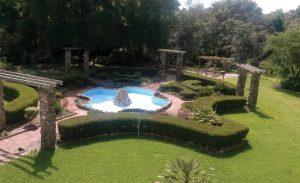 4. Ravine Gardens State Park, a 59-acre park located in Palatka, is listed on the National Register of Historic Places. The Works Progress Administration constructed cypress buildings, rock gardens and fieldstone terraces. Near the park entrance stands a 64-foot obelisk dedicated to Franklin D. Roosevelt.
4. Ravine Gardens State Park, a 59-acre park located in Palatka, is listed on the National Register of Historic Places. The Works Progress Administration constructed cypress buildings, rock gardens and fieldstone terraces. Near the park entrance stands a 64-foot obelisk dedicated to Franklin D. Roosevelt.
 5. Highlands Hammock State Park, a 9,000-acre New Deal Era park, is located four miles west of Sebring. Local citizens acquired the property in 1931 for environmental preservation. It became one of the four original Florida State Parks when the state park system was created in 1935. Housed in a CCC-built structure, the Florida Civilian Conservation Corps Museum provides an opportunity to learn more about the CCC and their camps.
5. Highlands Hammock State Park, a 9,000-acre New Deal Era park, is located four miles west of Sebring. Local citizens acquired the property in 1931 for environmental preservation. It became one of the four original Florida State Parks when the state park system was created in 1935. Housed in a CCC-built structure, the Florida Civilian Conservation Corps Museum provides an opportunity to learn more about the CCC and their camps.
 6. Mike Roess Gold Head Branch State Park, located in Clay County near Keystone Heights, covers about 2,000 acres. During the 1930s, seasoned craftsmen and young men from the CCC planted trees, cleared areas for campsites and built roads. Nineteen of the 23 original buildings constructed by the CCC remain. These buildings include cabins, a picnic pavilion, a blacksmith forge, support structures and the ranger station at the park entrance.
6. Mike Roess Gold Head Branch State Park, located in Clay County near Keystone Heights, covers about 2,000 acres. During the 1930s, seasoned craftsmen and young men from the CCC planted trees, cleared areas for campsites and built roads. Nineteen of the 23 original buildings constructed by the CCC remain. These buildings include cabins, a picnic pavilion, a blacksmith forge, support structures and the ranger station at the park entrance.
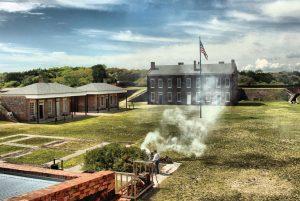 7. Fort Clinch State Park benefitted from the New Deal Era’s Civilian Conservation Corps through their construction, restoration, and shoreline stabilization projects. CCC Company 1420 worked at the park constructing the museum, campground and park roads as well as beginning the restoration of historic Fort Clinch. The men removed more than 10,000 cubic yards of sand and debris from the fort – by shovel and wheelbarrow alone.
7. Fort Clinch State Park benefitted from the New Deal Era’s Civilian Conservation Corps through their construction, restoration, and shoreline stabilization projects. CCC Company 1420 worked at the park constructing the museum, campground and park roads as well as beginning the restoration of historic Fort Clinch. The men removed more than 10,000 cubic yards of sand and debris from the fort – by shovel and wheelbarrow alone.
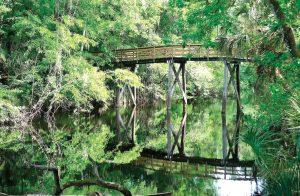 8. Opened in 1938, Hillsborough River State Park is one of Florida’s first state parks. In the 1930s, the Civilian Conservation Corps established the area surrounding the river rapids as a public park. Many park structures and the suspension bridge are examples of the CCC style of rustic architecture, designed to be in harmony with the natural environment.
8. Opened in 1938, Hillsborough River State Park is one of Florida’s first state parks. In the 1930s, the Civilian Conservation Corps established the area surrounding the river rapids as a public park. Many park structures and the suspension bridge are examples of the CCC style of rustic architecture, designed to be in harmony with the natural environment.
 9. Located nine miles east of Sarasota, Myakka River State Park, one of the oldest and largest state parks, covers more than 37,000 acres. CCC workers were transferred to Sarasota County from Green Cove Springs to establish the park in 1934. Most of the park’s rustic structures were built of natural materials, including limestone, cabbage palm logs and timber from the surrounding area. The palm log cabins reflect the CCC philosophy that park structures should blend with the environment.
9. Located nine miles east of Sarasota, Myakka River State Park, one of the oldest and largest state parks, covers more than 37,000 acres. CCC workers were transferred to Sarasota County from Green Cove Springs to establish the park in 1934. Most of the park’s rustic structures were built of natural materials, including limestone, cabbage palm logs and timber from the surrounding area. The palm log cabins reflect the CCC philosophy that park structures should blend with the environment.
From the few state parks constructed during the Great Depression has grown an award-winning Florida Park Service that manages 161 state parks and 10 state trails. Florida’s state parks hold the memories of our past cultures, preserve our native landscapes and protect our natural and cultural assets.
Learn more about our past, how state parks protect our future, and how you can enjoy the present state park system at FloridaStateParks.org. ![]()




